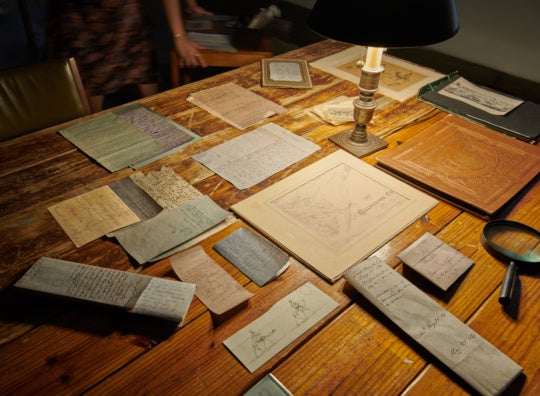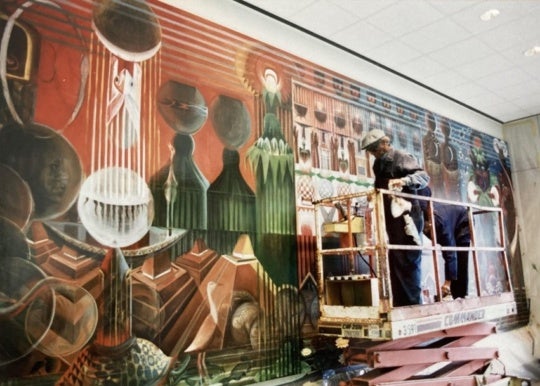
72 by 72 inches.
The four paintings and 12 drawings in “Life,” Brett Smith’s show at Sandler Hudson Gallery, present a consistent method of layering webs of short straight lines atop one another in palettes that are more or less monochromatic. Life is not just the title for the exhibition but is also the title of every piece, delineated by parenthetical addendums such as black square right 1 and green 1. Smith’s four canvases are 5 and 6 feet square, and the framed drawings are 22 by 30 inches.
The lines that make up his work are uniform in width but range in length. They are interconnected by angles that are mostly acute. The impression that results from these meticulous interconnections is vaguely evocative of webs, girders, or the matrices of crystals. These matrices rise up as flat planes and confront the viewer vertically. Each work has two or three of these planar matrices overlapping, the one at the forefront being the most saturated (dense black or straight permanent red, for example) with a submerged plane that exists as a pastel tone or even a fainter tertiary version of the foremost color. On the canvases, these submerged planes of lines are the most interesting materially, since they are dense with hairlike inscribed marks, as if made by a wire brush.
These works are fairly reductive. The components are simple (straight lines, angles, multiple levels) but the variations are technically endless. As viewers, we are conscious of the primacy of line in the works, since the surface tells us that those same lines are the components directly applied to the surface by hand. Simultaneously, the negative space presents a field of polygons. Though not every one of these polygons is triangular, prevalence of acute angles reminds us that all polygons can be subdivided into triangles. To the viewer who is interested in such reveries, Smith’s works can provide a walking meditation on geometry.

The arrangement of polygons has long been a form of escapism, reverie, and play. Many ancient games are based on a player’s ability to perceive polygons that describe their relationships or possible moves. The Asian game Go, for example, involves the placement of black and white pieces on a 19-by-19 grid. The player who can best discern hypothetical polygons within that grid, and the sequences it takes to create them, will prevail by surrounding his or her opponent’s pieces. Similar geometric projections are required in games like chess, set, and shogi. The game of pick-up sticks, sometimes called “jackstraws,” is also won according to a player’s ability to navigate a sequence within a geometric structure. The heap of dropped sticks in this game is literally a tangle of lines. The player who can best perceive the structure of this tangle is the one who will win by deconstructing the heap without causing it to collapse. We can observe a similar process of geometric projection in Smith’s work.
In a reductive language, decisions that normally would be considered small can suddenly loom large and attain greater significance. The angles where lines meet, for example, or the paper chosen as a substrate are both very important in Smith’s paintings and drawings. Unfortunately, some elements in these works appear to be the results of arbitrary factors rather than clear intentions. The colors chosen appear to be off the shelf primaries, which is odd considering the heavy role they play in such monochromatic works. The line width also feels unconsidered. On paper Smith’s lines rarely vary from the standard width of a manufactured pastel crayon, and on canvas they are consistently the approximate width of a piece of masking tape. Are these decisions crucial or are they simply parts of a generalized method? Smith may be playing it too safe. Without clear intentionality, a reductive strategy can become merely a way of occupying space.

There is a recent tradition of artists taking reductive language and merging it with a consideration of decorative pattern. Jim Hodges, Judy Ledgerwood, and Arturo Herrera come to mind. These artists offer us much needed exit strategies from post-minimal language. Is this where Smith is headed? Is he interested in a more private, personal meditation? Or is he fascinated with surface embellishment to the extent that he rejects other readings outright? These are questions that the work really does not answer, despite being highly resolved in other respects.
“Life” is a weighty title for any artwork to carry. In this era, we understand our physical lives as a very lengthy matrix of four proteins. Is our genomic code the “life” being referred to here? Or perhaps life is defined by activity, a narrative of perpetual endeavor that never duplicates itself exactly but appears to be uniform from a distance? Smith’s work possesses a certain beauty and orderliness. There is not, however, a great deal of traction for speculation about meaning or intention. The lines of “Life” are aching to be filled in.
“Brett Smith: Life” is on view at Sandler Hudson Gallery through July 11.
Orion Wertz is a painter and graphic novelist living in Columbus, Georgia. He is a professor at Columbus State University, where he teaches drawing and painting. He was a finalist for the 2015 Hudgens Prize.




